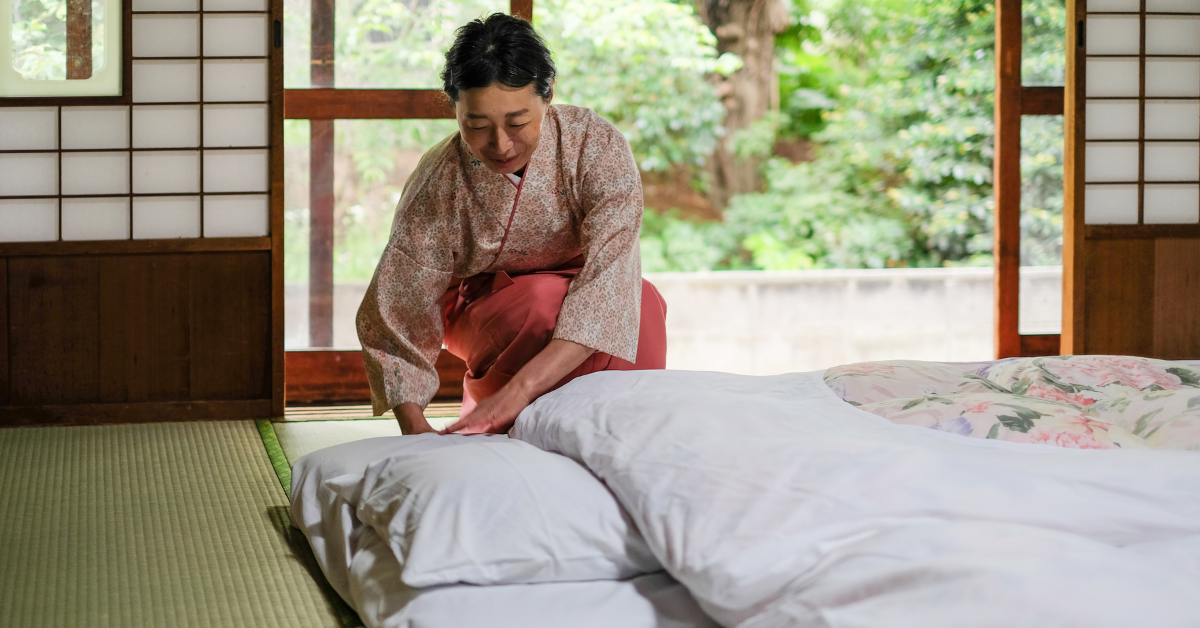A futon is more than just bedding in Japan. It reflects cultural traditions, seasonal lifestyle, and practical design that allow people to sleep comfortably while making efficient use of space. While the word “futon” abroad often refers to a sofa bed, the Japanese futon represents a unique way of life.
The Basic Meaning of Futon
A futon generally refers to a set of bedding composed of a “shikibuton” (mattress) and a “kakebuton” (quilt). The shikibuton supports the body, while the kakebuton covers and warms it. Japanese homes tend to be smaller compared to Western ones, and the ability to fold and store a futon in a closet has long been valued.
More than just bedding, futons are also a cultural tool adapted to lifestyle and climate. In colder regions, thicker futons are preferred, while in warmer areas, breathable futons are more common. This flexibility shows how closely futons are tied to daily life in Japan.
Differences Between Japanese Futons and Overseas Futons
| Item | Japanese Futon | Overseas “Futon” |
|---|---|---|
| Shape | Divided into shikibuton and kakebuton | Often sofa bed type |
| Usage | Laid directly on the floor for sleeping | Used as a sofa, unfolded into a bed |
| Material | Cotton, wool, down, polyester, etc. | Metal frame with cushion mattress |
| Storage | Foldable and stored in a closet | Usually fixed as furniture |
Japanese futons emphasize flexibility and storage efficiency, while overseas futons emphasize furniture convenience. Understanding this difference helps foreigners appreciate the Japanese futon experience.
Types of Futons
| Type | Features | Main Use |
|---|---|---|
| Shikibuton (mattress) | Supports the body; varies in thickness and firmness | Laid directly on tatami or flooring |
| Kakebuton (quilt) | Provides warmth; made from down, wool, or synthetic fibers | Seasonal use |
| Makura (pillow) | Supports the head and neck | Used with shikibuton |
| Hadakakebuton (light quilt) | Thin and lightweight | Used in summer or mild seasons |
The choice of futon can greatly affect sleep quality, and in Japan it is common for each family member to have futons suited to their preference.
Seasonal Use of Futons
Japan has four distinct seasons, and futons are adjusted accordingly.
| Season | Futon Used | Characteristics |
|---|---|---|
| Winter | Down quilt or thick kakebuton | Provides high insulation against cold |
| Spring | Light quilt | Moderate warmth, easy to adjust |
| Summer | Linen or gauze quilt | Excellent breathability, prevents overheating |
| Autumn | Light quilt or mid-weight quilt | Flexible for changing temperatures |
Through these adjustments, Japanese people maintain a comfortable sleeping environment without relying too heavily on air conditioning.
Futon Care and Cleanliness
To use futons comfortably for a long time, regular maintenance is essential. In Japan, airing futons in the sun is a common habit, which removes moisture and keeps them fresh.
| Care Method | Effect | Notes |
|---|---|---|
| Sun drying | Removes moisture, prevents dust mites | Best under direct sunlight |
| Futon dryer | Useful on rainy days or in winter | Many have mite-elimination functions |
| Washing covers | Keeps bedding hygienic and pleasant to touch | Fabrics vary by season |
This focus on cleanliness reflects Japanese lifestyle values and cultural sensitivity to hygiene.
The Futon Experience for Travelers
For foreign travelers, sleeping on futons at ryokan (traditional inns) or guesthouses is a memorable experience. Unlike Western beds, futons are laid on tatami mats, creating a unique and authentic Japanese sleeping style. At night, futons are arranged in the quiet of a Japanese room, and in the morning, they are folded away, allowing the space to be used efficiently.
Recently, many hotels and guesthouses have begun incorporating Japanese-style rooms, making futons increasingly accessible to foreigners. For many, futons are not just bedding, but an entry point to experiencing Japanese culture.
Conclusion
Futons are traditional Japanese bedding, and they differ significantly from the “futon” known overseas. The key characteristics of Japanese futons are storability, cleanliness, and seasonal adaptability. For travelers, futons are more than bedding – they are a way to experience Japan’s cultural depth.
Understanding futons is a step toward appreciating the richness of Japanese daily life. Experiencing the comfort and cultural significance of futons offers a deeper understanding of Japanese lifestyle and traditions.






